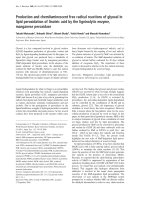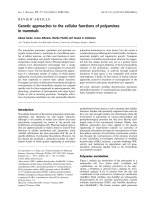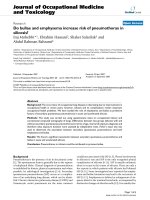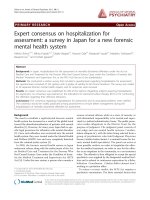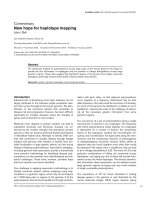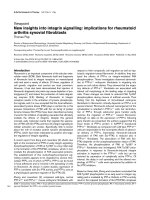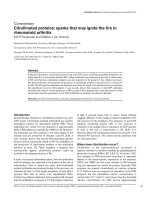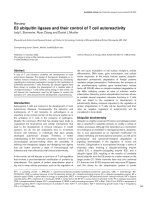Báo cáo y học: "New data favouring that neurotrophins are of importance in arthritis" pot
Bạn đang xem bản rút gọn của tài liệu. Xem và tải ngay bản đầy đủ của tài liệu tại đây (43.18 KB, 2 trang )
Available online />Page 1 of 2
(page number not for citation purposes)
Abstract
Neurotrophins are important in inflammation. In an article in Arthritis
Research & Therapy, Barthel and collaborators give new infor-
mation on the existence of neurotrophin production in the synovial
tissue of arthritic joints. These findings, together with other recent
findings, stress that neurotrophins should be considered important
factors in arthritis. This is reinforced by the facts that they are also
produced by articular chondrocytes and that receptors for these
are present in the synovial tissue and on chondrocytes. The
importance of neurotrophins in joints should be further studied,
including examinations on the efficacy of interfering with their
effects in arthritis.
In an article in Arthritis Research & Therapy, Barthel and
colleagues have described that cellular mRNA expressions
for the neurotrophins nerve growth factor (NGF) and brain-
derived neurotrophic factor (BDNF) are detectable both in
the synovial tissue and in the synovial fluid of arthritic patients
[1]. The expression for NGF was particularly noteworthy in
samples of patients with rheumatoid arthritis. NGF was not
expressed in fibroblast-like synoviocytes, as seen by ELISA
analysis on culture supernatant. The authors concluded that
infiltrating T lymphocytes and myeloid cells are the main
sources of NGF in the inflamed peripheral joint. Nevertheless,
the authors do not rule out the possibility that fibroblast-like
synoviocytes can produce NGF under certain circumstances.
These findings give new evidence for the importance of
neurotrophins for the inflammatory process in arthritis. The
group of neurotrophins, which apart from NGF and BDNF is
constituted of neurotrophin 3 and neurotrophin 4, has been
considered of importance in various types of inflammatory
conditions. In particular, NGF has been detected at high
levels in regions with inflammation. Accordingly, there are
high levels of NGF in the synovial fluid of rheumatoid arthritis
patients. Neurotrophins are also of importance as factors that
promote growth and survival of neurons, and they may be
involved in the pathogenesis of pain.
In accordance with the findings of Barthel and collaborators
[1], immunoreactions for NGF and BDNF have been found in
the inflammatory infiltrates of the synovial tissue of arthritic
mice but not in the synovial tissue of healthy mice [2].
Furthermore, cells in cultures of human synovial cells can
produce NGF [3], and immunoreactions for BDNF have been
detected in macrophages as well as in fibroblast-like synovio-
cytes in the synovial tissue of rheumatoid arthritis patients [4].
Of further importance is the fact that immunoreactions for
neurotrophins are also detectable in nerve structures of the
synovial tissue [2,5]. Immunoreactions for NGF and BDNF
are also detectable on chondrocytes, including articular
chondrocytes, as seen in studies on mouse joints [2].
Functional effects of neurotrophins are likely to occur within
the synovial tissue. Expressions of the low-affinity neuro-
trophin receptor p75 as well as the high-affinity neurotrophin
receptor TrkA are therefore present in the synovial tissue of
patients with spondyloarthritis [6]. Immunoreactions for p75
and the high-affinity receptor TrkB are also present in the
synovial tissue of rheumatoid arthritis patients, the receptors
being located in relation to the nerve structures [5]. The
results of a recent study suggest there is an upregulation of
NGF/TrkA in cytokine-activated fibroblast-like synoviocytes,
suggesting that there is a cross-talk between NGF and its
receptors in inflammatory arthritis [7]. Autocrine/paracrine
effects of neurotrophins also appear to occur concerning the
articular chondrocytes [2].
The effects of NGF in the inflamed synovium can be either
proinflammatory or protective and regenerative. There is thus
evidence that points in both directions. Interestingly, topical
Editorial
New data favouring that neurotrophins are of importance in
arthritis
Sture Forsgren
Department of Integrative Medical Biology, Anatomy Section, Umeå University, SE-901 87 Umeå, Sweden
Corresponding author: Sture Forsgren,
Published: 30 July 2009 Arthritis Research & Therapy 2009, 11:122 (doi:10.1186/ar2754)
This article is online at />© 2009 BioMed Central Ltd
See related research by Barthel et al., />BDNF = brain-derived neurotrophic factor; ELISA = enzyme-linked immunosorbent assay; NGF = nerve growth factor; TNF = tumour necrosis factor.
Arthritis Research & Therapy Vol 11 No 4 Forsgren
Page 2 of 2
(page number not for citation purposes)
application of NGF to human corneal and skin ulcers can
have healing actions [8] and, as seen in studies on rat injured
ligaments, local application of NGF may improve the healing
process [9]. Nevertheless, NGF does also have proinflam-
matory effects. One possibility is that the effects of NGF in
relation to inflammations vary over time, and furthermore that
NGF actually is related to the modulation of and not the
induction of the inflammation of joints [3].
Interestingly, neurotrophins have a relationship to TNFα. The
production of both NGF and BDNF can thus be stimulated by
TNFα. An effect on BDNF levels has been shown in response
to anti-TNF treatment. The BDNF levels in plasma were found
to be decreased in response to this treatment [5], a finding
that is supported by the observation of a tendency for a
decrease in plasma BDNF levels after anti-TNF treatment in a
previous preliminary report [10]. Furthermore, the degrees of
TrkA and p75 immunoreactions in spondyloarthritis synovitis
were reported to be downregulated by anti-TNF treatment
[6]. It cannot be excluded that the effects of anti-TNF
treatment on BDNF levels are not only related to effects on
local cells in the synovium, but also to effects on circulating
cells and/or BDNF-containing neurons [5].
The results in the recent study by Barthel and collaborators
and those obtained in other recent studies show collectively
that neurotrophins should be further considered as factors of
relevance in arthritic inflammation. It might be that the effects
of these should be interfered with in arthritis. Further studies
are needed in order to clarify whether antagonists or agonists
to NGF (or to BDNF) should be applied.
Competing interests
The author declares that they have no competing interests.
References
1. Barthel C, Yeremenko N, Jacobs R, Schmidt RE, Bernateck M,
Zeidler H, Tak P-P, Baeten D, Rihl M: Nerve growth factor and
receptor expression in rheumatoid arthritis and spondy-
loarthritis. Arthritis Res Ther 2009, 11:R82.
2. Grimsholm O, Guo Y, Ny T, Forsgren S: Expression patterns of
neurotrophins and neurotrophin receptors in the articular
chondrocytes and the inflammatory infiltrates in knee joint
arthritis. Cells Tissues Organs 2008, 188:299-309.
3. Manni L, Lundeberg T, Fiorito S, Bonini S, Vigneti E, Aloe L:
Nerve growth factor release by human synovial fibroblasts
prior to and following exposure to tumor necrosis factor-
alpha, interleukin-1 beta and cholecystokinin-8: the possible
role of NGF in the inflammatory response. Clin Exp Rheumatol
2003, 21:617-624.
4. Weidler C, Holzer C, Harbuz M, Hofbauer R, Angele P,
Scholmerich J, Straub RH: Low density of sympathetic nerve
fibres and increased density of brain derived neurotrophic
factor positive cells in RA synovium. Ann Rheum Dis 2005, 64:
13-20.
5. Grimsholm O, Rantapää-Dahlqvist S, Dalén T, Forsgren S: BDNF
in RA: downregulated in plasma following anti-TNF treatment
but no correlation with inflammatory parameters. Clin
Rheumatol 2008, 27:1289-1297.
6. Rihl M, Kruithof E, Barthel C, De Keyser F, Veys EM, Zeidler H, Yu
DT, Kuipers JG, Baeten D: Involvement of neurotrophins and
their receptors in spondyloarthritis synovitis: relation to
inflammation and response to therapy. Ann Rheum Dis 2005,
64:1542-1549.
7. Raychaudhuri SP, Raychaudhuri SK: The regulatory role of
nerve growth factor and its receptor system in fibroblast-like
synovial cells. Scand J Rheumatol 2009, 38:207-215.
8. Aloe L, Tirassa P, Lambiase A: The topical application of nerve
growth factor as a pharmalogical tool for human corneal and
skin ulcers. Pharmacol Res 2008, 57:253-258.
9. Mammoto T, Seerattan RA, Paulson KD, Leonard CA, Bray RC,
Salo PT: Nerve growth factor improves ligament healing.
J Orthop Res 2008, 26:957-964.
10. del Porto F, Aloe L, Lagana B, Triaca V, Nofroni I, DÁmelio R:
Nerve growth factor and brain-derived neurotrophic factor
levels in patients with rheumatoid arthritis treated with TNF-
αα
blockers. Ann NY Acad Sci 2006, 1069:438-443.
